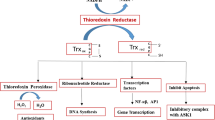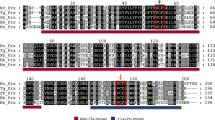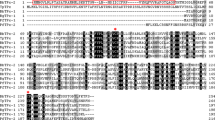Abstract
Reactive oxygen species produced from hemoglobin digestion and the host immune system could have adverse effects on malaria parasites. To protect themselves, malaria parasites are highly dependent on the antioxidant enzymes, including superoxide dismutases and thioredoxin-dependent peroxidases. To date, several thioredoxin peroxidases (TPx) have been characterized in Plasmodium falciparum, but the TPx in Plasmodium vivax has not yet been characterized. The complete sequence of gene coding for thioredoxin peroxidase-1 of P. vivax (PvTPx-1) was amplified by PCR and cloned. Using the recombinant PvTPx-1 (rPvTPx-1), polyclonal antibody was produced in mice for immunolocalization of the enzyme in the parasite. The antioxidant activity of rPvTPx-1 was evaluated by mixed-function oxidation assay. PvTPx-1 has two conserved cysteine residues in the amino acid sequence at the positions 50 and 170 which formed a dimer under a non-reducing condition. Using a thiol mixed-function oxidation assay, the antioxidant activity of rPvTPx-1 was revealed. Indirect immunofluorescence microscopy with the specific antibody indicated that PvTPx-1 was expressed in the cytoplasm of the erythrocytic stage of the parasite in a dots-like pattern. The results suggest that P. vivax uses TPx-1 to reduce and detoxify hydrogen peroxides in order to maintain their redox homeostasis and proliferation in the host body.
Similar content being viewed by others
Avoid common mistakes on your manuscript.
Introduction
Although huge efforts have been made to control malaria, it still remains as one of the most important global health problems. Plasmodium vivax, the second most prevalent malaria species after Plasmodium falciparum, has a wider geographical distribution and mostly co-exists with P. falciparum in endemic countries (Arevalo-Herrera et al. 2010). P. vivax causes 25–40% of malaria cases worldwide (Dharia et al. 2010) resulting to about 80 to 300 million clinical cases every year (Arevalo-Herrera et al. 2010). In spite of the public health importance of this human malaria parasite, less attention has been given on researches about P. vivax (Mendis et al. 2001).
Since malaria parasites proliferate in the human body and the mosquito vector that are oxygen-rich environments, the parasites are exposed to the toxic effects of reactive oxygen species (ROS) which might cause damages to their macromolecules (Kawazu et al. 2008; Kehr et al. 2010). Digestion of hemoglobin by malaria parasites produces heme, the prominent source of ROS in the parasite (Muller 2004). Moreover, the immune system of the host also induces the production of ROS to act against the parasites (Baert et al. 1999; Kawazu et al. 2008). In order to proliferate in the host body, malaria parasites protect themselves from the damages caused by ROS (Kehr et al. 2010). Since Plasmodium lacks catalase and genuine glutathione peroxidase, thioredoxin peroxidases play a vital role in the reduction of ROS (Kawazu et al. 2008; Kehr et al. 2010; Muller 2004).
Thioredoxin peroxidase-1 (TPx-1), which is primarily located in the cytosol (Kawazu et al. 2008), belongs to the family of thiol-specific antioxidant proteins (Wood et al. 2003). TPx-1 reduces and detoxifies hydrogen peroxides through the action of the redox-active cysteine (Wood et al. 2003). Based on the number and position of cysteine (Cys) residue, TPxs are divided into three types, namely: 1-Cys, typical 2-Cys, and atypical 2-Cys type (Vaca-Paniagua et al. 2009; Wood et al. 2003).
The susceptibility of the malaria parasite to the disturbance of their antioxidant system makes it a great potential target for the development of new drugs (Muller 2004). Artimisinin compounds, established as antimalarial in the 1990s, kill the parasites by generating free radicals and increasing oxidative stress (Warrell et al. 2002). In recent years, several researches have been made on the TPx of P. falciparum with six TPxs already characterized (Kawazu et al. 2000; Rahlfs and Becker 2001; Kawazu et al. 2008; Richard et al. 2011). However, the TPx in P. vivax has not been characterized yet. In this study, we cloned and characterized the TPx-1 from P. vivax.
Materials and methods
Cloning of the gene coding for the TPx-1 of P. vivax
The complete sequence of the gene coding for the TPx-1 of P. vivax (PvTPx-1) was amplified using the primer sets: 5′-CAT ATG CCG ACA TAC GTA GGA AAG G-3′ and 5′-GGA TTC TTA TAA TGT GGA CAA ATA CTG CGC-3′ (start and stop codons were underlined). The primers were designed using PlasmoDB (2011) database (accession number: PVX_118545) with the restriction enzyme sites NdeI and BamHI (italic). The PvTPx-1 gene was amplified from genomic DNA of the P. vivax sal 1 strain. The gene was shown as a single copy and had no introns in the genome. The PCR was done in 50 μl of reaction mixture containing 1.5 mM MgCl2, 200 μM of each dNTP and 1 μM of each primer as the final concentration, and 0.5 U of Taq DNA polymerase (Invitrogen, Tokyo, Japan). Each PCR cycle consists of denaturation at 94°C for 15 s, annealing at 50°C for 20 s, and extension at 68°C for 2 min and was repeated 35 times. It was followed by 68°C for 10 min as final extension. The expected length of the PCR product was 588 bp, and the gene sequence was analyzed using ABI Prism 3100 Genetic Analyzer (Applied Biosystems, Carlsbad, CA).
Expression and purification of recombinant PvTPx-1
The PCR product was digested with restriction enzymes NdeI and BamHI and then inserted into pET-28a expression vector (EMD Biosciences, San Diego, CA) by overnight incubation with ligation mixture (Takara, Otsu, Japan) at 15°C. The recombinant plasmid containing the coding sequence of PvTPx-1 was transfected into Escherichia coli (strain BL21). The transformed colony was incubated in SOB medium (BD, Sparks, MD) containing kanamycin (50 μg/ml) at 37°C until the optical density at 600 nm reached 0.6. Expression of the recombinant PvTPx-1 (rPvTPx-1) was induced by adding 1 mM isopropyl thio-β-d-galactoside (IPTG) and an additional 4 h of incubation. The bacterial culture was harvested by centrifugation, resuspended in the lysis buffer (100 mM sodium phosphate, pH 8.0; 10 mM Tris–Cl, pH 8.0), and sonicated for 10 min. Histidine-tagged recombinant protein in the supernatant was incubated with Ni-NTA agarose beads (Qiagen Inc., Valencia, CA). After washing two times, the captured protein was eluted by increasing the imidazol concentration in the elution buffer up to 200 mM. The purity of the recombinant protein was evaluated by 12% sodium dodecyl sulfate polyacrylamide gel electrophoresis (SDS/PAGE) under reducing conditions and subsequent Coomassie Brilliant Blue staining. The concentration of each expressed protein was measured using BCA assay (Thermo Scientific, Rockford, IL).
Antioxidant activity assay
The antioxidant activity of rPvTPx-1 was evaluated by mixed-function oxidation (MFO) assay (Sauri et al. 1995). The reaction mixture containing 40 μM FeCl3, 10 mM dithiothreitol (DTT), 20 mM EDTA, 25 mM HEPES, pH 7.0, was pre-incubated with or without the rPvTPx-1 protein (25–400 μg/ml) at 37°C for 1 h. After the pre-incubation period, 500 ng of pET-28a plasmid DNA was added. The reaction mixture was incubated for another 3 h. Nicking of the supercoiled plasmids by the MFO was evaluated by 0.8% agarose gel electrophoresis and ethidium bromide staining.
Indirect immunofluorescence microscopy
A hyperimmunized serum against rPvTPx-1 was developed by three-time immunization of BALB/c mice with a 2-week interval and titrated using enzyme-linked immunosorbent assay. A P. vivax-positive blood smear from an infected patient was fixed in 50% acetone–50% methanol solution for 5 min at −20°C. The antiserum in 5% skim milk which contained phosphate-buffered saline (PBS) was applied as primary antibody at 1:200 dilutions and incubated overnight at 4°C. The smear was washed three times (5 min each) in PBS with 0.05% Tween 20 (T-PBS). Alexa-Fluor® 488 conjugated goat anti-mouse IgG (Invitrogen Japan, Tokyo, Japan) was applied at 1:500 dilutions as secondary antibody and incubated for 30 min at 37°C. The smear was washed again three times with T-PBS and incubated with 5 μg/ml of Hoechst 33258 solution (DojinDO, Kumamoto, Japan) for 20 min at 37°C. After washing three times with T-PBS, the smear was examined under a confocal laser-scanning microscope (TCS-SP5, Leica Microsystem, Wetzlar, Germany). The animal experiments in this study were carried out in compliance with the Guide for Animal Experimentation at the Obihiro University of Agriculture and Veterinary Medicine.
Results and discussion
The PvTPx-1 gene was 588 bp in length and coded for a protein comprised of 195 amino acid residues with the predicted molecular mass and isoelectric point of 21.8 kDa and 6.51, respectively. Amino acid sequence analysis showed that PvTPx-1 has no signal peptide (SignalP 30 server, CBS, Technical University of Denmark). The pairwise sequence alignment of PvTPx-1 with P. falciparum TPx-1 (PfTPx-1) was done using genetic information processing software (GENETYX Corporation) showing 85.1% identity as seen in Fig. 1. The presence of two conserved cysteine residues at positions 50 and 170 has proved that it was a typical 2-Cys type TPx. SDS/PAGE under a non-reducing condition showed that the protein forms a dimer resulting from an intersubunit disulfide bond (Fig. 2c). TPx-1 has two conserved active Cys namely peroxidatic Cys and resolving Cys (Wood et al. 2003). The peroxidatic Cys of one subunit is attacked by resolving Cys in the C-terminus of the other subunit and making a disulfide bond between two molecules in the action for reducing peroxide (Wood et al. 2002, 2003). The 2-Cys disulfide in the oxidized enzyme is reduced by another biothiol such as thioredoxin wherein the dimer dissociates into two regenerated monomers as reduced enzymes (Wood et al. 2003).
Amino acid sequence alignment of PfTPx-1 and PvTPx-1. Asterisks indicate the conserved cysteine residues and peroxisome targeting signal 1 (PTS1), and the PTS1-like motifs at the C-terminus of PfTPx-1 and PvTPx-1 are underlined, respectively. The identical residues between the two sequences are boxed
a Agarose gel electrophoresis image of the PCR-amplified PvTPx-1 gene. PvTPx-1 was successfully amplified (lane 1). M indicates the 100-bp marker (Takara, Otsu, Japan). b SDS/PAGE image of recombinant PvTPx-1 (rPvTPx-1). rPvTPx-1 was expressed in E. coli. M marker. Lane 1 is the E. coli culture before adding IPTG, lane 2 is 4 h after adding IPTG, and lane 3 is purified rPvTPx-1. c SDS/PAGE image of recombinant PvTPx-1. M marker. Lane 1 is 200 ng of rPvTPx-1 under the reducing condition (with 2-mercapto ethanol), and lane 2 is 200 ng of rPvTPx-1 under the non-reducing condition (without 2-mercapto ethanol)
In order to evaluate the enzyme activity and develop an antibody against PvTPx-1, the recombinant protein was produced (Fig. 2b). The antioxidant activity of rPvTPx-1 was evaluated by MFO assay (Fig. 3). The production of hydroxyl radicals in the reaction mixture of the assay damages the DNA (Sauri et al. 1995). In the absence of rPvTPx-1, FeCl3 and DTT produced hydroxyl radicals giving nicks in the supercoiled plasmid DNA and thus changing the running behavior of the DNA in the agarose gel (Fig. 3, lane 3). However, in the reaction mixtures containing 400, 200, and 100 μg/ml of rPvTPx-1, the nicking of the plasmid DNA was not observed (Fig. 3, lanes 4–6). This suggested that rPvTPx-1 has antioxidant activity.
MFO assay to evaluate rPvTPx-1 antioxidant activity. Prevention of the nicking of the plasmid DNA was evaluated by MFO assay. The nicking was visualized by 0.8% agarose gel electrophoresis. Lane 1 pET-28a plasmid DNA and FeCl3; lane 2 pET-28a plasmid DNA and DTT; lane 3 pET-28a plasmid DNA, FeCl3, and DTT; lanes 4–7 pET-28a plasmid DNA, FeCl3, DTT, and 400, 200, 100, and 25 μg/ml of rPvTPx-1, respectively. The nicked form (NF) and supercoiled form (SF) are indicated on the right
Immunofluorescence microscopy was performed to localize the expression of TPx-1 in P. vivax. Figure 4 shows a mature schizont with several merozoites. The dots-like pattern of the PvTPx-1 expression in the cytoplasm suggests that the molecule may have organelle localization. This expression pattern in the parasite cytoplasm was also shown in PfTPx-1 (Yano et al. 2005). The amino acid sequence of PfTPx-1 has SKL peroxisome targeting signal 1 (PTS1) at the C-terminus (Fig. 1) (McIntosh et al. 2005), whereas PvTPx-1 contains PTS1-like motif (STL) at its C-terminus (Fig. 1). Despite the presence of PTS1 and PTS1-like motif, a conventional peroxisome does not exist in Plasmodium, but rather, peroxidase active organelles are present in the cytoplasm of the parasite (McIntosh et al. 2005). Transmission electron microscopy should therefore be done to know whether TPx-1 can localize at these organelles in the parasite cytoplasm. This cytosolic expression of TPx-1 was reported in other protozoan parasites such as Babesia bovis (Tanaka et al. 2009). Moreover, the homologous enzyme is reported in the helminth parasites such as Haemonchus contortus and Schistosoma (Vaca-Paniagua et al. 2009) and was also suggested to have a housekeeping role in the parasite cell (Kawazu et al. 2008; Vaca-Paniagua et al. 2009).
a Indirect immunofluorescence microscopy to confirm PvTPx-1 expression in the parasite cell. The figure shows a mature schizont with several merozoites (M). PvTPx-1 expression in an intraerythrocytic P. vivax schizont was observed by indirect immunofluorescence microscopy using the recombinant PvTPx-1-immunized mouse serum. The solid arrow shows cytoplasmic localization of PvTPx-1, and the dotted arrow shows signals in the nucleus
The presence of green fluorescence inside the nucleus of merozoites which stained with Hoechst suggests the nuclear expression of PvTPx-1. Although TPxs are primarily located in the cytoplasm (Wood et al. 2003), the first nuclear expression of TPx was reported in the yeast which possibly protects DNA from oxidative damage (Park et al. 2000). However, there are still no reports on the nuclear expression of TPx-1 in Plasmodium (Kawazu et al. 2008). Immunofluorescence microscopy using polyclonal antibody against PvTPx-1 on P. falciparum showed only cytoplasmic signal whereas no reaction was seen in the nucleus (data not shown). This might suggest that nonspecific reactions are unlikely to occur. Interestingly, the idea that PvTPx-1 can localize in the nucleus should be investigated in future studies.
References
Arevalo-Herrera M, Chitnis C, Herrera S (2010) Current status of Plasmodium vivax vaccine. Hum Vaccines 6:124–132
Baert CB, Deloron P, Viscogliosi E, Delgado-Viscogliosi P, Camus D, Dive D (1999) Cloning and characterization of iron-containing superoxide dismutase from the human malaria species Plasmodium ovale, P. malaria and P. vivax. Parasitol Res 85:1018–1024
Dharia NV, Bright AT, Westenberger SJ, Barnes SW, Batalov S, Kuhen K, Borboa R, Federe GC, McClean CM, Vinetz JM, Neyra V, Llanos-Cuentas A, Barnwell JW, Walker JR, Winzeler EA (2010) Whole-genome sequencing and microarray analysis of ex vivo Plasmodium vivax reveal selective pressure on putative drug resistance genes. Proc Natl Acad Sci USA 107:20045–20050
Kawazu S, Komaki-Yasuda K, Oku H, Kano S (2008) Peroxiredoxins in malaria parasites: parasitologic aspects. Parasitol Int 57:1–7
Kawazu S, Tsuji N, Hatabu T, Kawai S, Matsumoto Y, Kano S (2000) Molecular cloning and characterization of a peroxiredoxin from the human malaria parasite Plasmodium falciparum. Mol Biochem Parasitol 109:165–169
Kehr S, Sturm N, Rahlfs S, Przyborski JM, Becker K (2010) Compartmentation of redox metabolism in malaria parasites. PLoS Pathog 6:e1001242
McIntosh MT, Elliot DA, Joiner KA (2005) Plasmodium falciparum: discovery of peroxidase active organelles. Exp Parasitol 111:133–136
Mendis K, Sina BJ, Marchesini P, Carter R (2001) The neglected burden of Plasmodium vivax malaria. AmJTrop Med Hyg 64:97–106
Muller S (2004) Redox and antioxidant systems of the malaria parasite Plasmodium falciparum. Mol Microbiol 53:1291–1305
Park SG, Cha M, Jeong W, Kim I (2000) Distinct physiological functions of thiol peroxidase isoenzymes in Saccharomyces cerevisiae. J Biol Chem 275:5723–5732
PlasmoDB (2011) Plasmodium Genomic Resource, PlasmoDB. At: http://www.plasmodb.org/plasmo. Accessed 24 June 2011
Rahlfs S, Becker K (2001) Thioredoxin peroxidases of the malaria parasite Plasmodium falciparum. Eur J Biochem 268:1404–1409
Richard D, Bartfai R, Volz J, Ralph SA, Muller S, Stunnenberg HG, Cowman AF (2011) A genome-wide chromatin-associated nuclear peroxiredoxin from the malaria parasite Plasmodium falciparum. J Biol Chem 286:11746–11755
Sauri H, Butterfield L, Kim A, Shau H (1995) Antioxidant function of recombinant human natural killer enhancing factor. Biochem Biophys Res Commun 208:964–969
Tanaka M, Sakurai T, Yokoyama N, Inoue N, Kawazu S (2009) Cloning and characterization of peroxiredoxin in Babesia bovis. Parasitol Res 105:1473–1477
Vaca-Paniagua F, Parra-Unda R, Landa A (2009) Characterization of one typical 2-Cys peroxiredoxin gene of Taenia solium and Taenia crassiceps. Parasitol Res 105:781–787
Warrell DA, Watkins WM, Winstanley PA (2002) Treatment and prevention of malaria. In: Warrell DA, Gilles HM (eds) Essential malariology, 4th edn. Arnold, London, pp 270–271
Wood ZA, Poole LB, Hantgan RR, Karplus PA (2002) Dimers to doughnuts: redox-sensitive oligomerization of 2-cysteine peroxiredoxins. Biochemistry 41:5493–5504
Wood ZA, Schroder E, Robin Harris J, Poole LB (2003) Structure, mechanism and regulation of peroxiredoxins. Trends Biochem Sci 28:32–40
Yano K, Komaki-Yasuda K, Kobayashi T, Takemae H, Kita K, Kano S, Kawazu S (2005) Expression of mRNAs and proteins for peroxiredoxins in Plasmodium falciparum erythrocytic stage. Parasitol Int 54:35–41
Acknowledgments
The authors are grateful to Dr. Takafumi Tsuboi of Ehime University for providing the P. vivax sal 1 DNA sample and Dr. Shigeyuki Kano of the National Center for Global Health and Medicine for the blood smears of the P. vivax-infected patient. This work was supported by a Grant-in-Aid for Scientific Research (23390098) from the Japan Society for the Promotion of Science.
Author information
Authors and Affiliations
Corresponding author
Rights and permissions
About this article
Cite this article
Hakimi, H., Asada, M., Angeles, J.M.M. et al. Cloning and characterization of Plasmodium vivax thioredoxin peroxidase-1. Parasitol Res 111, 525–529 (2012). https://doi.org/10.1007/s00436-012-2864-3
Received:
Accepted:
Published:
Issue Date:
DOI: https://doi.org/10.1007/s00436-012-2864-3








